"Inside Out" leads the way with 14 nominations.
The post Pixar Dominates the Annie Awards With Record 25 Nominations appeared first on Cartoon Brew.
Add a Comment
"Inside Out" leads the way with 14 nominations.
The post Pixar Dominates the Annie Awards With Record 25 Nominations appeared first on Cartoon Brew.
Add a CommentNew chapters of Mouse in Transition will be published every Friday on Cartoon Brew. It is the story of Disney Feature Animation—from the Nine Old Men to the coming of Jeffrey Katzenberg. Ten lost years of Walt Disney Production’s animation studio, through the eyes of a green animation writer. Steve Hulett spent a decade in Disney Feature Animation’s story department writing animated features, first under the tutelage and supervision of Disney veterans Woolie Reitherman and Larry Clemmons, then under the watchful eye of young Jeffrey Katzenberg. Since 1989, Hulett has served as the business representative of the Animation Guild, Local 839 IATSE, a labor organization which represents Los Angeles-based animation artists, writers and technicians. Read Chapter 1: Disney’s Newest Hire Read Chapter 2: Larry Clemmons Read Chapter 3: The Disney Animation Story Crew Read Chapter 4: And Then There Was…Ken! Read Chapter 5: The Marathon Meetings of Woolie Reitherman Read Chapter 6: Detour into Disney History Read Chapter 7: When Everyone Left Disney Read Chapter 8: Mickey Rooney, Pearl Bailey and Kurt Russell “Chief has to DIE,” Ron Clements said. “The picture doesn’t work if he just breaks his LEG. Copper doesn’t have enough motivation to hate the fox.” Ron looked at me intently, shaking his head. He was a supervising animator on The Fox and the Hound, and was just then in the process of making a jump into the story department. He was something of a perfectionist and (for some reason) wanted the story to be better. Ron had worked for a season at Hanna-Barbera and then entered the Disney training program, apprenticing with veteran animator Frank Thomas. Within a decade he would be co-directing Disney’s breakout blockbuster The Little Mermaid, but at this moment he was unhappy with the story arc of The Fox and the Hound. “I agree with you, Ron,” I said. “Agree completely. But do you think Art Stevens will buy a change like that?” “I don’t know. But we have to try. The picture needs to be stronger.” The Fox and the Hound had a three-act structure. The second act had the fox, Tod, involved with a railroad accident. The old dog Chief gets knocked off a tall bridge by a thundering locomotive, and Tod gets unfairly blamed for the accident. Chief dies in the book on which the movie is based, but in the Disney version, the elderly dog only suffers a broken leg. Even so, Copper (the young bloodhound) angrily vows revenge against his friend Tod. Ron and most of the younger story crew thought Copper’s anger and lust for revenge was several clicks over the top, considering Tod’s minor sin. So Ron and the rest of us pleaded the case to the lead director: “Please let’s have Chief DIE.” Art was skittish about it, and said no. No surprise there. So the same argument was hauled upstairs to Disney’s management, with the same reaction: “You can’t kill off a lovable central character! Children will FREAK OUT! Parents will hate us! WE’LL GET LETTERS!!” Neither tearful pleas nor the example of Bambi’s mother catching a bullet could change the directors’ or the top brass’s minds. They wouldn’t kill Chief, and that was final. Ron Clements was not a guy who easily took “No” for an answer, but after a protracted campaign, he dropped the issue. Arguing was as pointless as jousting with windmills. (I had dropped the issue earlier. I am not a big believer in banging my head against hard, thick walls.) But it was one more point of dissatisfaction between the recently-arrived Young Turks and the Disney Animation establishment. The old timers from the 1930s were gone, but the generation that had rolled in during the 1940s and 1950s was finally holding the tiller, and they were bound and determined not to cede their newly acquired power and leverage to a bunch of goddamn kids in their goddamn twenties. Many of the “kids” were from California Institute of the Arts, the Disney-funded college in Valencia, California that served as a training ground for a lot of the animation industry. Walt Disney Productions had, in recent years, skimmed off the cream of the CalArts crop, and recent grads like John Musker, Henry Selick, Brian McEntee, Bruce Morris, Joe Ranft, Mikes Cedeno, Mike Giamo, Tim Burton, Jerry Rees, and an ebullient CalArts star named John Lasseter (among numerous others) populated the animation building. A 1980 volleyball game between the Disney producers and artists. The color commentary and play-by-play by John Musker reveals the underlying tensions between the two camps. Video by Randy Cartwright. Most of the CalArts group groused about the old-timers’ stodgy, moldy fig attitudes, and the stodgy, moldy fig product that resulted therefrom. They had been against the Bluth forces; now they chafed against the veterans’ tightly-held reins. Brad Bird had already gotten his ass fired for making his gripes too loud and too public, but the general mood of frustration and desire to try something fresh, new, and different continued. Even with the bad feelings, various CalArts graduates were being groomed for better things. Early on, John Musker jumped on a career track pointed toward director. John Lasseter was assigned to different projects in development. Bruce Morris and Joe Ranft quickly worked their way into story development. But the veterans remained territorial…and a touch paranoid. I remember Art Stevens saying, “Who do these pipsqueaks think they ARE?! They’re not geniuses. They can’t come in here and have their way after fifteen minutes!” (Another old-timer told me: “Art spent years in John Lounsbery’s unit as his key assistant. And Art would get furious if artists in their group tried to move up and out. He always wanted everybody to stay where they were, to not change anything. He’d get offended if anybody tried to jump ship.”) Tim Burton, bent over a light board down on the first floor, was becoming known for his very un-Disney character sketches. Joe Ranft, Darrell van Citters, Brian McEntee, Mike Giamo, Jim Mitchell, and …
Add a Comment
Whether it be for lack of budget or a desire to take center stage, series creators lending their own voices to their animated television shows has always been fairly commonplace – Mike Judge (Beavis and Butthead, King of the Hill), John Kricfalusi (Ren and Stimpy), Seth MacFarlane (Family Guy) and Trey Parker and Matt Stone (South Park) immediately spring to mind. However, in recent years, more and more feature directors have started getting in on the trend. From throwaway one-liners to continuous roles throughout entire franchises, here is a list of some animation directors and the characters they brought to life in their own films.
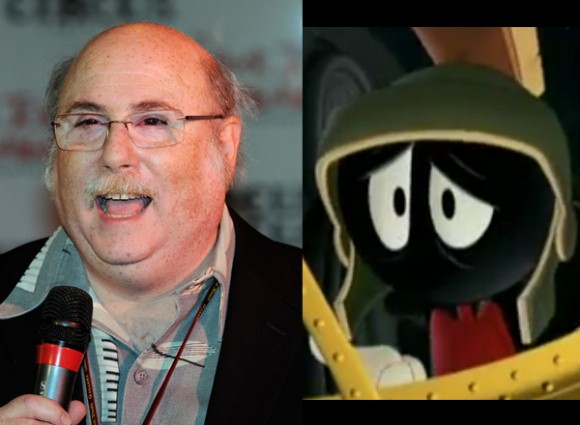 As the animation director for Looney Tunes: Back in Action (2003), Goldberg not only supervised the animation of the WB’s classic characters but he voiced some of them as well. Goldberg recorded the dialogue of Marvin the Martian, Tweety Bird and Speedy Gonzalez.
As the animation director for Looney Tunes: Back in Action (2003), Goldberg not only supervised the animation of the WB’s classic characters but he voiced some of them as well. Goldberg recorded the dialogue of Marvin the Martian, Tweety Bird and Speedy Gonzalez.
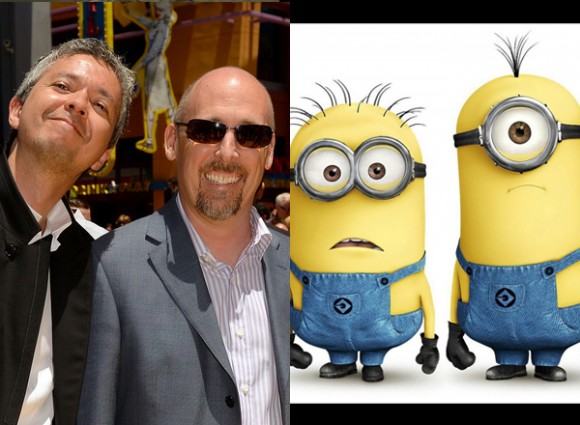 The distinctive sputters, spurts and high-speed mutterings of The Minions in Despicable Me (2010) and Despicable Me 2 (2013) belong to the films’ co-directors Pierre Coffin (above left) and Chris Renaud. And as the character’s popularity grows, so does their vocal commitment, as the two will reprise their roles in next year’s prequel Minions.
The distinctive sputters, spurts and high-speed mutterings of The Minions in Despicable Me (2010) and Despicable Me 2 (2013) belong to the films’ co-directors Pierre Coffin (above left) and Chris Renaud. And as the character’s popularity grows, so does their vocal commitment, as the two will reprise their roles in next year’s prequel Minions.
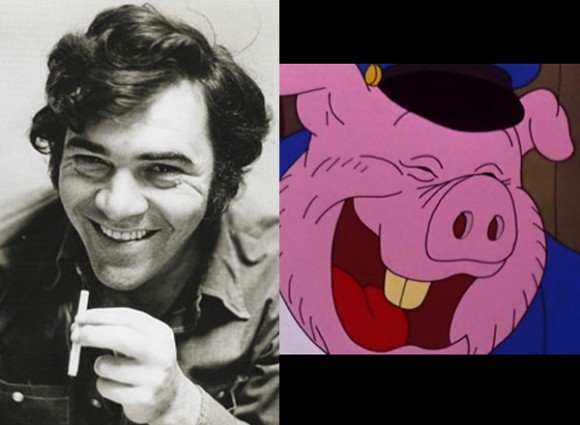 In his debut film Fritz the Cat (1972), director Ralph Bakshi voiced one of the boorish antagonist Pig Cops, who is also referred to as “Ralph” multiple times in his scenes.
In his debut film Fritz the Cat (1972), director Ralph Bakshi voiced one of the boorish antagonist Pig Cops, who is also referred to as “Ralph” multiple times in his scenes.
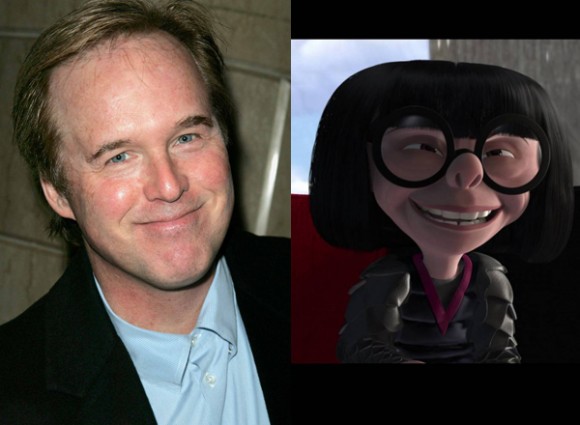 Agnes Gooch, Edith Head, Patricia Highsmith, Linda Hunt – when it comes to figuring out who inspired the character of Edna Mode, people love to toss out many names, but in the end, the cutthroat designer of superhero fashion was brought to life by The Incredibles (2004) director Brad Bird.
Agnes Gooch, Edith Head, Patricia Highsmith, Linda Hunt – when it comes to figuring out who inspired the character of Edna Mode, people love to toss out many names, but in the end, the cutthroat designer of superhero fashion was brought to life by The Incredibles (2004) director Brad Bird.
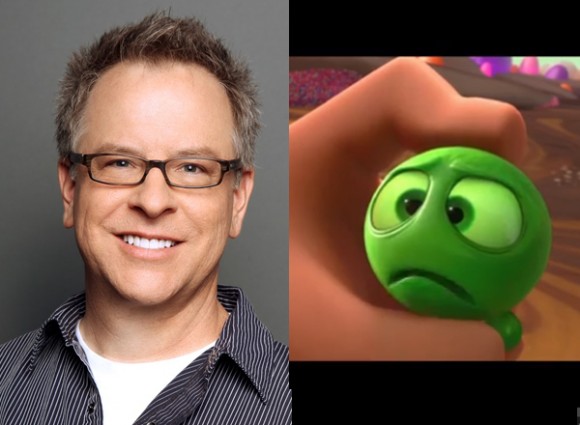 Rich Moore, director of Wreck-It Ralph (2012) provided the dreary monotone of acidic jawbreaker Sour Bill, the henchman to the bombastic King Candy.
Rich Moore, director of Wreck-It Ralph (2012) provided the dreary monotone of acidic jawbreaker Sour Bill, the henchman to the bombastic King Candy.
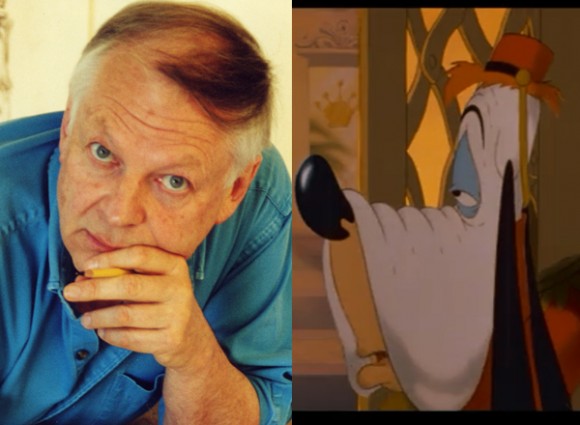 Even to this day, the toon celebrity cameos in Who Framed Roger Rabbit(1988) remain some of the best nods to the golden age of cartoons, especially that of Droopy Dog, who gets his opportunity to best Eddie Valiant with some traditional ‘toon high-jinks as a tricky elevator operator, sluggishly voiced by the film’s animation director Richard Williams.
Even to this day, the toon celebrity cameos in Who Framed Roger Rabbit(1988) remain some of the best nods to the golden age of cartoons, especially that of Droopy Dog, who gets his opportunity to best Eddie Valiant with some traditional ‘toon high-jinks as a tricky elevator operator, sluggishly voiced by the film’s animation director Richard Williams.
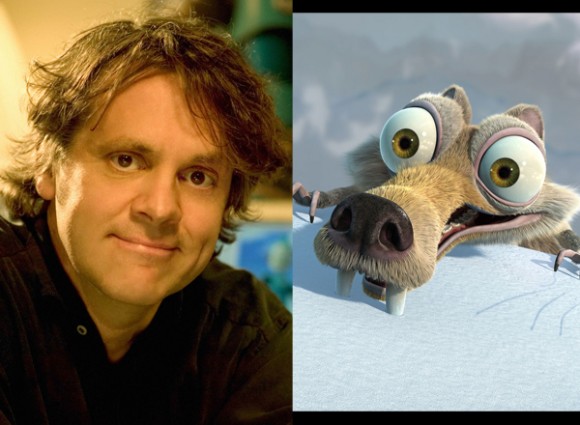 What began as the high-strung snivels and snarls of Scrat in Ice Age (2002) has become a second career for director Chris Wedge who has gone on to vocally personify the prehistoric rodent in 3 sequels, 6 short films, 2 video games and in a walk-on role in an episode of Family Guy.
What began as the high-strung snivels and snarls of Scrat in Ice Age (2002) has become a second career for director Chris Wedge who has gone on to vocally personify the prehistoric rodent in 3 sequels, 6 short films, 2 video games and in a walk-on role in an episode of Family Guy.
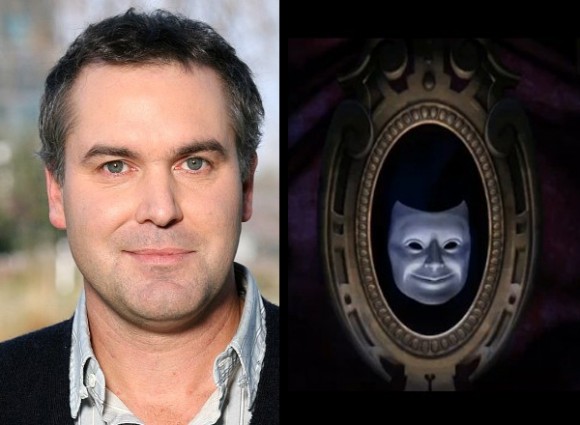 Royal messengers, tower guards, army commanders, friars and penguins, story artist Chris Miller has lent his voice-over skills to numerous animated films, most notably his returning roles as Geppetto and The Magic Mirror in the Shrek franchise, including Shrek the Third (2007), which he co-directed.
Royal messengers, tower guards, army commanders, friars and penguins, story artist Chris Miller has lent his voice-over skills to numerous animated films, most notably his returning roles as Geppetto and The Magic Mirror in the Shrek franchise, including Shrek the Third (2007), which he co-directed.
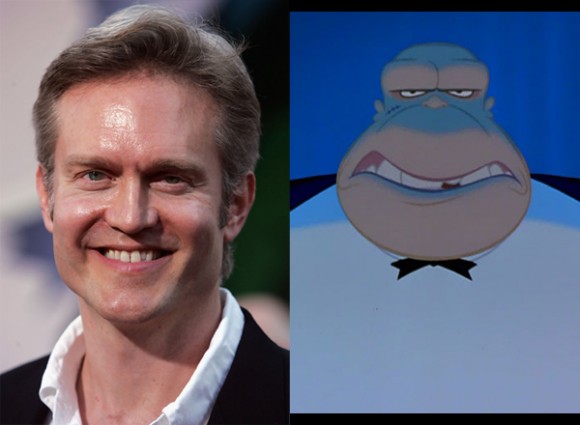 The often ignored and underrated animated film Cats Don’t Dance (1997) features some beautiful hand-drawn work and stellar vocal performances, including that of director Mark Dindal as the tight-lipped bodyguard/butler Max.
The often ignored and underrated animated film Cats Don’t Dance (1997) features some beautiful hand-drawn work and stellar vocal performances, including that of director Mark Dindal as the tight-lipped bodyguard/butler Max.
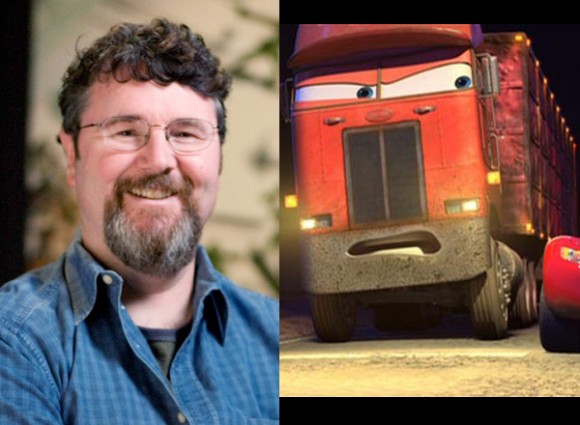 Pixar story artist, the late Joe Ranft, brought a handful of memorable animated characters to life, including Heimlich (A Bug’s Life), Wheezy the Penguin (Toy Story 2) and Jacques the Cleaner Shrimp (Finding Nemo). But it was in Cars (2006), which he co-directed, that he voiced three characters including the semi-truck Jerry Recycled Batteries.
Pixar story artist, the late Joe Ranft, brought a handful of memorable animated characters to life, including Heimlich (A Bug’s Life), Wheezy the Penguin (Toy Story 2) and Jacques the Cleaner Shrimp (Finding Nemo). But it was in Cars (2006), which he co-directed, that he voiced three characters including the semi-truck Jerry Recycled Batteries.
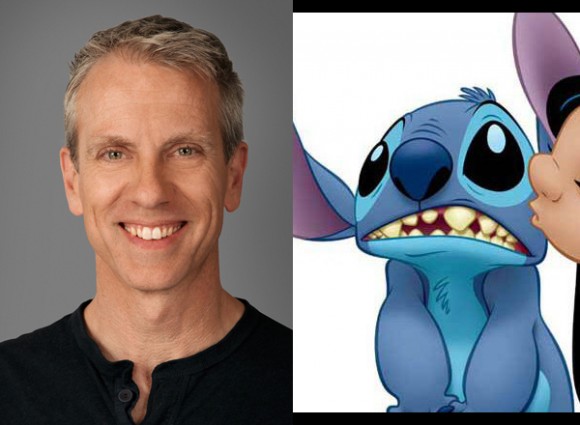 In Lilo & Stitch (2002) co-director Chris Sanders takes on the nuanced role of Alien Experiment 626, aka “Stitch,” who escapes from an intergalactic prison only to find himself trapped on the Hawaiian island of Kauai.
In Lilo & Stitch (2002) co-director Chris Sanders takes on the nuanced role of Alien Experiment 626, aka “Stitch,” who escapes from an intergalactic prison only to find himself trapped on the Hawaiian island of Kauai.
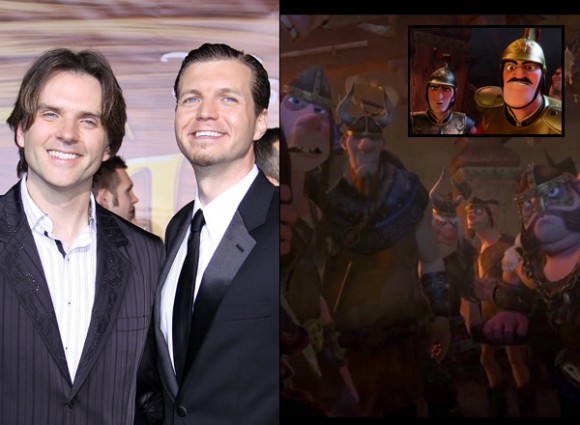 Nathan Greno (above right) and Byron Howard not only paired up as co-directors of Tangled (2010) but also doubled as duos of Thugs and Guards in the animated picture.
Nathan Greno (above right) and Byron Howard not only paired up as co-directors of Tangled (2010) but also doubled as duos of Thugs and Guards in the animated picture.
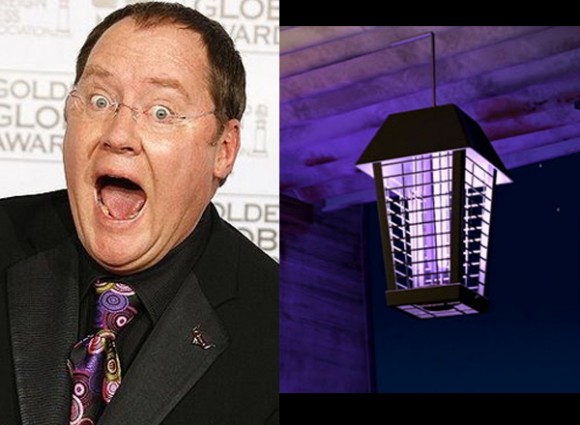 With five features under his belt, John Lasseter has had plenty of opportunity to throw himself behind the microphone, however upon review of his filmography, you’ll find he has chosen his roles very carefully, as the role of John Lassetire in Cars 2 (2011) and the hilariously bug-zapped Harry the Mosquito in A Bug’s Life (1998).
With five features under his belt, John Lasseter has had plenty of opportunity to throw himself behind the microphone, however upon review of his filmography, you’ll find he has chosen his roles very carefully, as the role of John Lassetire in Cars 2 (2011) and the hilariously bug-zapped Harry the Mosquito in A Bug’s Life (1998).
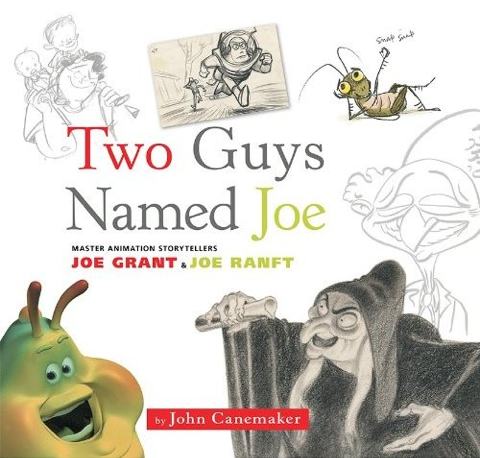
John Canemaker’s eagerly anticipated book, Two Guys Named Joe: Master Animation Storytellers Joe Grant & Joe Ranft, will arrive in stores in early August. The book focuses on the lives and careers of two master animation storytellers who passed away in 2005—Disney veteran Joe Grant and Pixar’s Joe Ranft (who also started his career at Disney). Grant was 97 years old; Ranft was 45—and that’s just the tip of the iceberg in terms of how these men were different. Their combined work has influenced animated features as diverse as Snow White and the Seven Dwarfs, Fantasia, Dumbo, Beauty and the Beast, The Nightmare Before Christmas, Toy Story, and Cars.
As an award-winning author of books such as Winsor McCay — His Life and Art, Felix: The Twisted Tale of the World’s Most Famous Cat and Walt Disney’s Nine Old Men and the Art of Animation, we’ve come to expect nothing less than excellence from John Canemaker’s books and he delivers yet again with Two Guys Named Joe. I conducted an in-depth interview with John via e-mail a couple weeks ago about his new book. Enjoy!
Interview follows after the jump
Amid Amidi: Let’s start with basics—why should artists today care about the careers of these two guys named Joe?
John Canemaker: To add to their knowledge of what constitutes excellent benchmarks in animation storytelling, narrative and character development; to find inspiration in knowing the impact that a singular talent can have on an entire film; to discover a creative work ethic that they can (and should) adopt as their own.
Joe Ranft’s mantra was “Trust the Process” and Joe Grant had a sign on his office door reading, “Get to work.” Both artists held the same philosophy regarding the creative process: just do it! Sit down and start in and, if you stick with it, ideas will occur and even flow, visual/verbal connections will be made in concepts, story sketches and scripts. Be open to all ideas and criticisms, make changes, make more changes, and problems will eventually be solved. In their own ways, both Joes were extremely positive and practical in their disciplined approach toward getting beyond the artist’s eternal dilemma: confronting the blank page.
I also think readers of Two Guys Named Joe will find compelling the struggles and challenges each artist confronted, endured and overcame in his personal and professional life.
AA: How did you initially come up with the idea to connect these two artists together?
JC: I knew both Joes for a number of years and interviewed them often for various projects. I considered them friends and enjoyed visiting with them in their respective studios and homes. They were witty, intelligent, superbly gifted, fully alive individuals whose deaths in the same year (2005) deeply saddened me, as it did many around the world.
I got to thinking about how similar they were despite a half-century age gap: their positive can-do approach toward making art, their bottomless creativity, the classic films they worked on, everything from SNOW WHITE to TOY STORY; the difference they made in the art form of character animation; how they each mentored other artists, and more.
Through the art and lives of these two particular guys named Joe, I saw the possibility of an overview of the history of storytelling at Disney and Pixar through a very human stor
Add a Comment